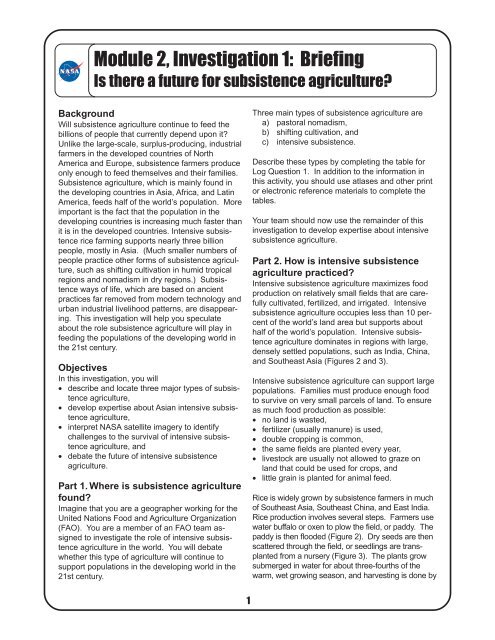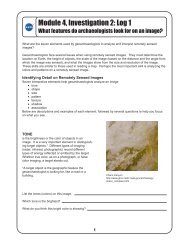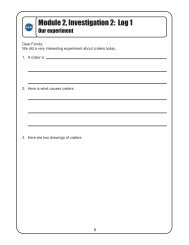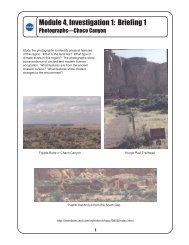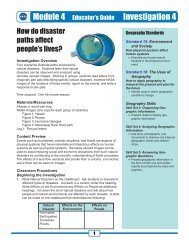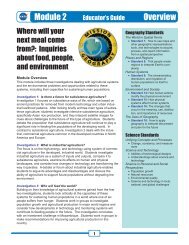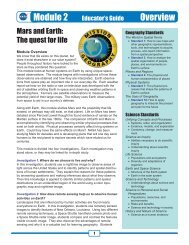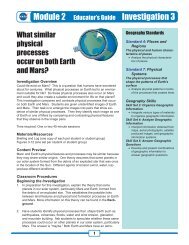Module 2, Investigation 1: Briefing - Mission Geography
Module 2, Investigation 1: Briefing - Mission Geography
Module 2, Investigation 1: Briefing - Mission Geography
You also want an ePaper? Increase the reach of your titles
YUMPU automatically turns print PDFs into web optimized ePapers that Google loves.
<strong>Module</strong> 2, <strong>Investigation</strong> 1: <strong>Briefing</strong>Is there a future for subsistence agriculture?BackgroundWill subsistence agriculture continue to feed thebillions of people that currently depend upon it?Unlike the large-scale, surplus-producing, industrialfarmers in the developed countries of NorthAmerica and Europe, subsistence farmers produceonly enough to feed themselves and their families.Subsistence agriculture, which is mainly found inthe developing countries in Asia, Africa, and LatinAmerica, feeds half of the world’s population. Moreimportant is the fact that the population in thedeveloping countries is increasing much faster thanit is in the developed countries. Intensive subsistencerice farming supports nearly three billionpeople, mostly in Asia. (Much smaller numbers ofpeople practice other forms of subsistence agriculture,such as shifting cultivation in humid tropicalregions and nomadism in dry regions.) Subsistenceways of life, which are based on ancientpractices far removed from modern technology andurban industrial livelihood patterns, are disappearing.This investigation will help you speculateabout the role subsistence agriculture will play infeeding the populations of the developing world inthe 21st century.ObjectivesIn this investigation, you will• describe and locate three major types of subsistenceagriculture,• develop expertise about Asian intensive subsistenceagriculture,• interpret NASA satellite imagery to identifychallenges to the survival of intensive subsistenceagriculture, and• debate the future of intensive subsistenceagriculture.Part 1. Where is subsistence agriculturefound?Imagine that you are a geographer working for theUnited Nations Food and Agriculture Organization(FAO). You are a member of an FAO team assignedto investigate the role of intensive subsistenceagriculture in the world. You will debatewhether this type of agriculture will continue tosupport populations in the developing world in the21st century.Three main types of subsistence agriculture area) pastoral nomadism,b) shifting cultivation, andc) intensive subsistence.Describe these types by completing the table forLog Question 1. In addition to the information inthis activity, you should use atlases and other printor electronic reference materials to complete thetables.Your team should now use the remainder of thisinvestigation to develop expertise about intensivesubsistence agriculture.Part 2. How is intensive subsistenceagriculture practiced?Intensive subsistence agriculture maximizes foodproduction on relatively small fields that are carefullycultivated, fertilized, and irrigated. Intensivesubsistence agriculture occupies less than 10 percentof the world’s land area but supports abouthalf of the world’s population. Intensive subsistenceagriculture dominates in regions with large,densely settled populations, such as India, China,and Southeast Asia (Figures 2 and 3).Intensive subsistence agriculture can support largepopulations. Families must produce enough foodto survive on very small parcels of land. To ensureas much food production as possible:• no land is wasted,• fertilizer (usually manure) is used,• double cropping is common,• the same fields are planted every year,• livestock are usually not allowed to graze onland that could be used for crops, and• little grain is planted for animal feed.Rice is widely grown by subsistence farmers in muchof Southeast Asia, Southeast China, and East India.Rice production involves several steps. Farmers usewater buffalo or oxen to plow the field, or paddy. Thepaddy is then flooded (Figure 2). Dry seeds are thenscattered through the field, or seedlings are transplantedfrom a nursery (Figure 3). The plants growsubmerged in water for about three-fourths of thewarm, wet growing season, and harvesting is done by19
<strong>Module</strong> 2, <strong>Investigation</strong> 1: <strong>Briefing</strong>Is there a future for subsistence agriculture?hand. This wet rice cultivation must bedone on flat land (like river valleys anddelta regions). As the need for expandedproduction rises, many farmers terracethe hillsides of river valleys to producemore flat land.Wet rice cultivation requires a constantsupply of water through irrigation anddrainage. Figure 4 is a Space Shuttleimage of Bangkok, Thailand, showingthe network of canals used for irrigationfor agriculture and domestic waterconsumption.Figure 2: Chinese rice farmer using a handoperatedpump to draw water from a canalSource: http://www.fao.org/NEWS/FOTOFILE/Ph9716-e.htm, FAO photo by F.BottsFigure 3: Indian women farmers transplantingriceAlthough women produce more than half the food grown globally, inmany countries their nutritional needs are met only after men andchildren have had enough.Source: http://www.fao.org/NEWS/FOTOFILE/PH9737-e.htm, FAOphoto by G. BizzariFigure 4: Space Shuttle photographyof Bangkok, ThailandIn an infrared photograph, the vegetation appearsreddish in hue. In this west-looking view, the city ofalmost four million people has a vast network of canalsthat are used for irrigation and drainage.Source: http://images.jsc.nasa.gov/images/pao/STS45/10064754.htm210
<strong>Module</strong> 2, <strong>Investigation</strong> 1: <strong>Briefing</strong>Is there a future for subsistence agriculture?Part 3: How is wet rice traditionallycultivated in China?Farmers in some of the more remote parts of China(such as Hunan, Jiangxi, Anhui, inland parts ofFujian and Zhejiang, inland/mountain parts ofGuangdong, Guangxi, Guizhou, and some areas ofSichuan) still practice traditional wet rice farming.They plant two crops of rice a year (doublecropping)where it is warm and wet. In the doublecroppingcycle, farmers• turn the soil with an iron-tipped wooden plowpulled by a water buffalo early in March andAugust;• rake the plowed soil smooth, fertilize, andwater the plot (they must keep the water inthe rice field at the proper level as the plantsgrow);• transplant rice seedlings from seedbeds intothe prepared plot from the middle of Marchand August (the entire family works in thefield taking seedlings by the bunch andpushing them into the soft, water-coveredsoil, as shown in Figure 3);• weed the crop in April and September(weeding is done by hand, and everyone oldenough for such work participates);• weed and fertilize again in May and October;• allow the rice to stand to “draw starch” to fillthe hull of the kernels (they let water out ofthe fields when the kernels draw enoughstarch, and both soil and stalks dry underthe Sun); and• harvest in late June or early July and inNovember; they cut off rice plants a fewinches above the ground with a sickle; thenthey separate the rice from the other parts ofthe crop (Figure 5), which are used for fuel.When harvest work is done, farmers begin plowingfor the next crop. They use the slack season of therice crop for vegetable gardening. In the hot anddamp period of late spring and summer, they groweggplant and several varieties of squash andbeans. After harvesting a crop of vegetables, theyturn the soil and break up the clods with a digginghoe, and level it with an iron rake to prepare for anew crop. They weed vegetables constantly, waterwith the long handled wooden dipper two or threetimes a day, and fertilize often (Yang 1959).Answer Question 2 on Log.Figure 5: Women winnowing rice inMyanmarSource: http://www.fao.org/NEWS/FOTOFILE/PH9722-e.htm, FAOphoto by G. Bizzarri311
<strong>Module</strong> 2, <strong>Investigation</strong> 1: <strong>Briefing</strong>Is there a future for subsistence agriculture?Figure 6: Intensive subsistence wheatagriculture around the Great Wall, northcentralChinaThis radar image, taken on August 3, 1995, shows a segment of theGreat Wall. Most of the image is taken up by rectangular patternsindicating agricultural development, primarily wheat fields. The GreatWall appears as a thin orange band, running from the top to thebottom of the left image. The wall is easily detected from space byradar because its steep, smooth sides provide a prominent surface forreflection of the radar beam.Source: http://www.jpl.nasa.gov/radar/sircxsar/gwall.htmlPart 4. What are other types of intensivesubsistence agriculture?In addition to wet rice cultivation, intensive subsistenceagriculture also occurs in drier areas whereirrigation is available to provide water for cropsduring dry seasons. The land is still fully plantedwith a variety of grains and other crops. Theseinclude wheat, barley, oats, corn, sorghum, millet,soybeans, cotton, hemp, and flax. For example,intensive subsistence wheat agriculture is foundaround the Great Wall of China in a desert regionof north-central China, about 700 kilometers westof Beijing (Figure 6).Figure 7: Mulberry fields and fish pondsin Jiangsu province in eastern ChinaSource: http://www.fao.org/NEWS/FOTOFILE/PH9811-e.htm,FAO photo by H. ZhangIn many wet areas, aquaculture, or fish farming, ispracticed, usually integrated with agriculture(Figures 7 and 8). Fish provide an importantsource of protein. In a world of land and waterscarcity, fish ponds have an advantage overfeedlots in producing low-cost animal protein. Incontrast to meat production, which is concentratedin industrial countries, some 85 percent of fish412Figure 8: Indian workers harvest carpraised in an inland aquaculture pondSource: http://www.fao.org/NEWS/FOTOFILE/ph9711-e.htm, FAOphoto by I. de Borhegyi
<strong>Module</strong> 2, <strong>Investigation</strong> 1: <strong>Briefing</strong>Is there a future for subsistence agriculture?farming is in developing countries. China, wherefish farming began more than 3,000 years ago,accounted for 21 million tons of the 31 million tonsof world aquaculture output in 1998. India was adistant second with 2 million tons. Other developingcountries with large aquaculture production includeBangladesh, Indonesia, and Thailand (Brown2000).Beijing, China, LANDSAT scene 123/32Data extract is 35 kilometers wide26 Oct 1976Complete Question 3 on the Log.Part 5. What are the challenges to intensivesubsistence agriculture in the 21stcentury?This investigation began by posing the question ofwhether intensive subsistence agriculture willcontinue in the 21st century. The answer to thisquestion may depend upon current and futurechallenges to this form of agriculture. ExamineFigure 9 for clues to one important challenge tosubsistence agriculture, and write your observationson the Log at Question 4.To consider another challenge to intensive subsistenceagriculture, study the image in Figure 10,which shows an area in the southern part ofBorneo, in Indonesia, and record your observationsin the Log at Question 5.03 Oct 1984MSSMSS16 May 1991Figure 9: Urban expansion of Beijing,China, over 15 years, as seen by thegrowth of the area in light blue color,which is the signature of concrete inthe infrared imageSource: http://see.gsfc.nasa.gov/edu/SEES/globa/class/Chap_8/8_Js/8-03.jpg513TM
<strong>Module</strong> 2, <strong>Investigation</strong> 1: LogIs there a future for subsistence agriculture?1. Use individual or group research to complete the table below.CharacteristicPastoralNomadismShiftingCultivationIntensiveSubsistence3 countriesrepresentative oftype1)2)1)2)1)2)3)3)3)ClimatePercentage ofworld land areacoveredPopulationdensity (high,medium, or low)Percentage ofworld populationsupportedOutput per unitarea (high,medium, or low)Output per unit ofhuman effort(high, medium, orlow)Other715
<strong>Module</strong> 2, <strong>Investigation</strong> 1: LogIs there a future for subsistence agriculture?2. On the timeline below, write in the annual activities of traditional wet rice double-cropping in China.Write the steps for crop #1 on the left and for crop #2 on the right.3. Identify six important features of intensive subsistence agriculture on your own as you read the <strong>Briefing</strong>.1)2)3)4)5)6)JanuaryFebruaryMarchAprilMayJuneJulyAugustSeptemberOctoberNovemberDecember917
<strong>Module</strong> 2, <strong>Investigation</strong> 1: LogIs there a future for subsistence agriculture?4. Using the information on Figure 9, provide a quantitative description of the changes over the 15-yearperiod shown by the three images. How do these changes challenge subsistence agriculture?5. What do you think is shown in Figure 10, and how might this be related to intensive subsistenceagriculture?6. List three arguments, either for or against the proposition that subsistence agriculture will continue toplay a significant role in feeding the populations of the developing world in the 21st century.1018


